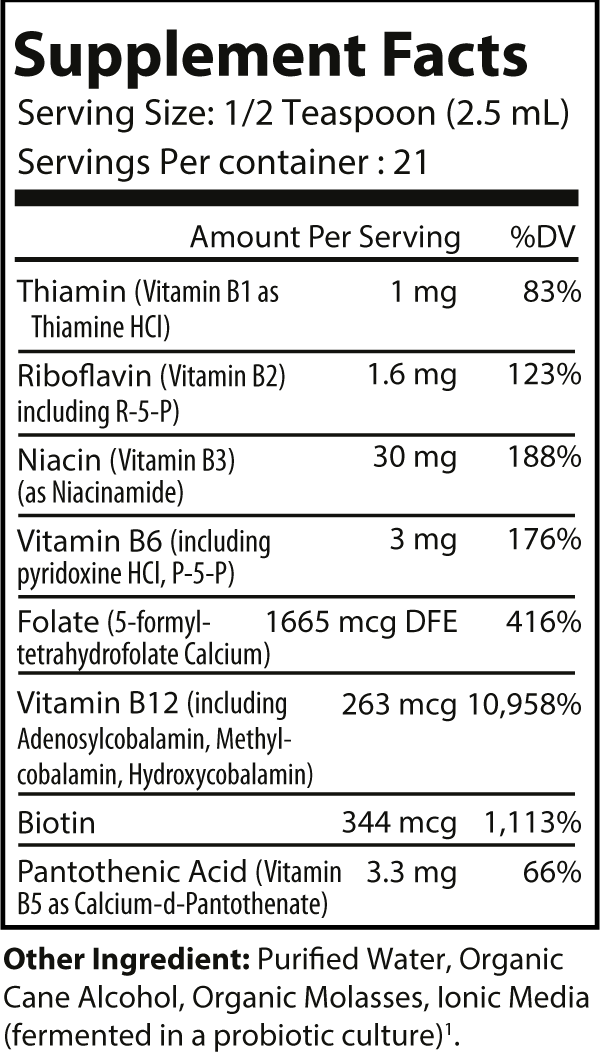REVITALIZE
We share your passion for pushing your limits and achieving optimal health. We're more than just a supplement store; we're your partner in reaching your fitness goals.

- QUICK LINKS
- Home
- Visit Store
- About
- Contact


Medical Grade Supplement Line
Couldn't load pickup availability
| Formula Purposes & Benefits |
|
Fermented B Complex 2oz is based on cutting-edge scientific research and expert formulation to support liver health, immune health, adrenal health, mood balance, balanced stress levels, and increased energy. Fermented B Complex 2oz utilizes bioavailable B-vitamins to provide comprehensive health support. It stands out with its revolutionary probiotic-fermented B vitamins, making it a groundbreaking formula in the nutrition industry. What sets Fermented B Complex 2oz apart is its innovative ND Technology™ (Novel Micro-cultured Delivery), which enhances oral absorption and bioenergetic properties. Users have reported remarkable effects from the first dose, confirming its exceptional quality and effectiveness. Our formula is proudly made in the USA in an FDA registered facility, following Good Manufacturing Practices (GMP) standards. Our commitment to excellence is reflected in the fact that only 4% of the supplements on the market can match our world-class standards. |
| Formula Ingredient Deck | Benefits Of Each Ingredient |
| Vitamin B1 (Thiamine) |
● May support aerobic energy metabolism (oxidative phosphorylation), cell growth, optimal neuronal conduction (nerve impulses), and cardiovascular health (94). ● May support cardiovascular function and aids as a neuroprotective agent in individuals with vitamin B-1 deficiencies (94, 95). |
|
Vitamin B-2 (Riboflavin)
|
● May support conversion and activation of other B vitamins, red blood cell production and serves as a cofactor for both glucose and fat metabolism (energy production) (92,93). |
| Vitamin B3 (Niacin) |
● Major B vitamin that supports cardiovascular health by inhibiting hepatic(liver) triglyceride synthesis, reduced very-low-density lipoprotein (VLDL) secretion, and increasing HDL plasma concentrations (8,9,10,11). ● May reduce conversion of VLDL into LDL proteins and serum lipoprotein concentrations in plasma (blood) (8,9,10,11). ● Vital for regulation of gene expression, cell cycle progression, and DNA repair, and cell death (8,9,10,11). ● May support healthy inflammatory responses via antioxidant and anti-apoptotic (prevention of cell death) properties (8,9,10,11). ● May support cognitive health by reducing the age-related decline of NAD+, increasing quinolinic acid, and reducing neuroinflammation (8,9,10,11). ● Increased niacin-associated NAD+ levels have been shown to support neurotransmission, learning, and memory (8,9,10,11). ● Niacin may reduce the prevalence of neurodegenerative pathologies by supporting mitochondrial dysfunction (8,9,10,11). |
| Vitamin B-6 |
● Serves as a cofactor in more than 150 enzymatic reactions associated in blood sugar regulation, immunity, cardiovascular function, neuronal health, metabolic, and digestive health (38, 40). ● May support blood sugar regulation via reduced plasma glucose (blood sugar levels) inhibiting the activity of small-intestinal α-glucosidases (enzymes associated with glucose metabolism) (39). ● May support antioxidant status by counteracting the formation of reactive oxygen species (inflammatory markers) and advanced glycation end-products (38,40). ● May support blood sugar regulation in women with gestational diabetes (40). ● Cofactor for enzymes involved in DNA metabolism (40) |
|
Folate (as 5-Methyltetrahydrofolate)
|
● May support proper cell growth and DNA synthesis (65). ● May support cognitive function with individuals who have MTHFR gene mutation (381). |
| Biotin |
● May support conversion of food into cellular energy, hair health, skin health, and cognitive function (213,214). ● May enhance glucose breakdown into skeletal muscle tissue (213,214). |
|
Vitamin B5 (Pantothenic Acid)
|
● May support energy production, cell growth, cell repair, cognitive function, increased hippocampal volume (memory), and optimized bioenergetics (burning of carbohydrates, fat, and protein) (96). |
| Proper Use of This Supplement |
| Suggested Use: Take 1/2 teaspoon mixed in 1/4 cup water or juice, once daily. Shake gently before use. Refrigerate after opening. |
Our Formula Vs Other Formulas on the Market.
| 1. Uses third party independently tested ingredients that are made in the USA, GMP certified, and made in an FDA registered facility. | 1. Source cheap ingredients from heavily polluted soils. Even “organic” supplements not third party tested have been removed by FDA due to high levels of heavy metals. |
|
2. High quality B-vitamins in a bioavailable and efficaciously dosed formula.
|
2. Uses synthetic cheap b-vitamins that may have heavy metals and fillers due to poor product quality. |
| 3. Uses ND Technology™ (Novel Micro-cultured Delivery), which enhances oral absorption and bioenergetic properties. | 3.Does not patented technology nutrient delivery system. |
Sources:
9.Gentilcore D. (2016). Louis Sambon and the Clash of Pellagra Etiologies in Italy and the United States, 1905-14. Journal of the history of medicine and allied sciences, 71(1), 19–42. https://doi.org/10.1093/jhmas/jrv002
10.Kirkland J. B. (2009). Niacin status and treatment-related leukemogenesis. Molecular cancer therapeutics, 8(4), 725–732. https://doi.org/10.1158/1535-7163.MCT-09-0042
11.Hoskin, P., Rojas, A., & Saunders, M. (2009). Accelerated radiotherapy, carbogen, and nicotinamide (ARCON) in the treatment of advanced bladder cancer: mature results of a Phase II nonrandomized study. International journal of radiation oncology, biology, physics, 73(5), 1425–1431. https://doi.org/10.1016/j.ijrobp.2008.06.1950

* These statements have not been evaluated by the Food and Drug Administration. This product is not intended to diagnose, treat, cure or prevent any disease.


We share your passion for pushing your limits and achieving optimal health. We're more than just a supplement store; we're your partner in reaching your fitness goals.

*These statements have not been evaluated by the FDA. These products are not intended to diagnose, treat, cure or prevent any disease.